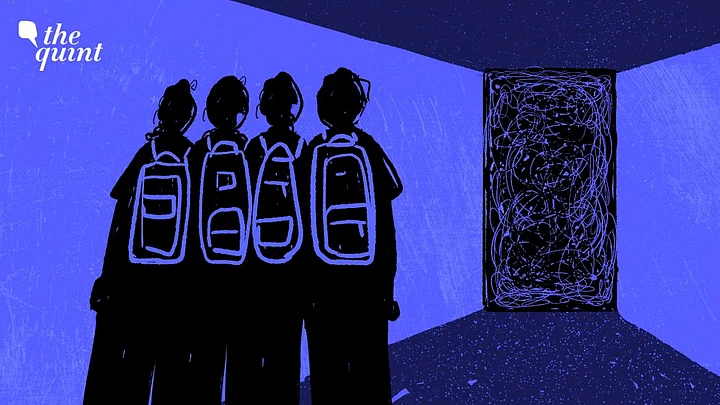(If you feel suicidal or know someone in distress, please reach out to them with kindness and call these numbers of local emergency services, helplines, and mental health NGOs.)
Five students have died by suicide in Tamil Nadu in the past two weeks. All five deceased were aged 17, and were studying in class 12.
The emerging pattern has raised an alarm and begs the question: Is suicide contagious?
Speaking to The Quint, Dr Srinivas Rajkumar, a consultant psychiatrist in Chennai, explained, "Humans have an inherent tendency for modelling. If they find someone going through the same phase of life, having the same problem, they relate to it and try to mimic their behaviour."
Copycat suicide is used to describe the phenomenon when one case of death by suicide trigger others in its wake.
Notably, the imitation effects of suicidal behaviour are often media-induced.
What Is Copycat Suicide & Werther Effect?
Copycat suicide is an emulation of another, usually highly-publicised, suicide that the person attempting suicide knows about either from local knowledge or due to accounts of it in the media.
The Werther Effect is used to describe a spike in copycat suicides.
The American Psychological Association (APA) defines the Werther Syndrome as: "A cluster suicide induced by the suicide of a well-known or popular role model whose death is given extensive coverage by the media."
The phenomenon is named for the first identified instance of media-triggered suicide, which occurred in 1774 following the publication of the novel Die Leiden des Jungen Werthers (The Sorrows of Young Werther) by Johann Wolfgang von Goethe.
Many young men of the time imitated the eccentric style of dress of the book’s protagonist, Werther, by dressing in blue and yellow. Soon after the novel became popular, a spate of young men died by suicide in the same way as Werther in the novel.
Werther Effect in India
Of the five students reported dead by suicide in Tamil Nadu since 13 July, at least three are said to have been under intense academic pressure.
"Modelling happens when the other person closely fits your profile. If a student is also in 12th standard, also going to appear for an exam, you may closely relate to them, their situation," notes Dr Srinivas Rajkumar.
The unfortunate succession of suicides in Tamil Nadu is not the first instance when a pattern of this kind has been observed in India.
As recently as May this year, a grim trend of deaths by suicide was observed in the Kolkata film industry after television actress and model Pallavi Dey was found dead at her residence on 15 May.
Sensational news reports and television programmes had carried everything from the mode and time of her expiration to the hyperbolist speculations around her relationship with her partner.
Days after Dey's death, actress Bidisha De Majumder was found dead at her home on 25 May. Majumder's demise was followed by those of model Manjusha Niyogi on 27 May and actress Saraswati Das on 29 May. The circumstances of the deaths in all four cases was eerily similar.
A deliberation on the media coverage of suicide in India would be incomplete without the mention of Sushant Singh Rajput – journalism has seldom been yellower than in the weeks following the young actor's death in 2020.
A slew of suicide cases had come to the fore as news reports mimicking whodunnits divulged everything from the actor's last Google searches to what he ate in his final hours.
"If he can do it, why can't I?" a tenth standard student had written in a suicide note two days after Rajput's death.
What Can We Do To Prevent Copycat Suicide?
The World Health Organization (WHO) lists good media reporting as one of the six effective interventions for suicide prevention.
Director Of Mental Health & Behavioural Sciences at Fortis Healthcare, Dr Samir Parikh, emphasises that the guidelines for reporting on suicide are well-established.
"Don't sensationalise. Don't write about the details of the death or the last note, if found. Don't place the story on the front page or a prominent spot. In every story, mention helpline numbers. The story should be written in a solution-oriented, preventative manner."Dr Samir Parikh, Director Of Mental Health & Behavioural Sciences at Fortis Healthcare
Media reports or programmes flouting these norms pose a greater risk of encouraging suicidal ideation. It has also been observed that after one incident of suicide is recorded, any subsequent ones that follow are also covered more promptly in news.
"If you give someone a manual, and they are already in distress, then the likelihood of them taking suggestion increases. They think that is the only way forward," says Dr Rajkumar.
Here are some simple guidelines advocated by the WHO for media professionals:
Avoid saying 'committed'; instead say died of suicide
Use people-first language
Don't use sensationalist language
Include helpline numbers in articles
Don't give too many details
Take particular care in reporting celebrity suicides
Educate the public about suicide myths
Exercise caution in using images
We should not discuss methods of suicide
Focus on life, not death
De-link suicide and depression or mental illness
The Werther Effect has a higher prevalence in the youth, as they may be more prone to suggestion, Dr Parikh notes. At the same time, peer support in this age group can also reduce the likelihood of suicidal behaviour.
Interestingly, exposure to accounts of suicidal behavior in the media can even have an educative or preventive effect, when constructive coping strategies or other solutions to adverse life circumstances are presented.
Such reporting is associated with a lower risk of suicide attempts, and can even have a positive impact. The term Papageno Effect has been coined for this phenomenon.
"If a media report is solution-oriented, if it talks about reaching out to family or friends or professionals and coping with the problem, it will promote help-seeking," says Dr Rajkumar.

